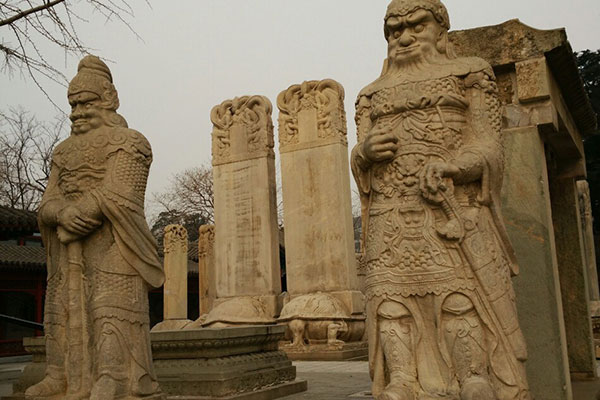
The Beijing Stone Carving Art Museum, which houses 2,600 stone artifacts, will reopen to the public on Dec 31 after a two-year renovation that cost more than 10 million yuan.[Wang Kaihao / China Daily]
They may be just stones. But they shed light on the history of Beijing. After two years of careful renovation, the Beijing Stone Carving Art Museum will reopen to the public on Dec 31.
A highlight will be the more than 750 stone artifacts reflecting the city’s history showcased in a 3,900-square-meter exhibition space.
Some artifacts date back to the Han Dynasty (202 BC-AD 220), but most are from the Yuan (1271-1368), Ming (1368-1644) and Qing (1644-1911) dynasties, when Beijing was the capital.
The Beijing Stone Carving Art Museum, which opened in 1987, now houses 2,600 stone carvings collected from all over the city.
Many works were unearthed during construction work in recent years.
“We redesigned the exhibition,” says Wang Dan, director of the museum.
“We did not want the exhibits to be shown like a chronicle, which is often done by history museums. However, it would be a little chaotic if we mixed too many things within a certain historical period.”
Another reason for adjustment is believed to be that some stone carvings were too heavy to be moved.
“They’re not regular museum exhibits. So, it’s better to minimize the impact on the relics, and design the visitors’ route based on their current locations,” says Wang.
The exhibition is split into three areas, and multiple independent themes are covered in each area. For example, while one section focuses on stone calligraphy rubbings, another focuses on stele-stone or wooden slabs, generally taller than wider, erected as monuments-recording major constructions in Beijing history, like bridges, roads and temples.
Though the constructions may have disappeared, their birth certificates-the stele-are preserved.
“Unlike stone carvings in Europe, which remind people of sculptures or reliefs, Chinese stone carvings are closely connected with calligraphy,” says Wang.
“If visitors can leave the museum admiring the beauty of Chinese characters, we will be very satisfied.”
Tombstones comprise a major part of the museum’s inventory.
According to the epitaphs, many were done to honor high officials under emperors’ orders.
There is also an area for tombstones of Christian missionaries. They were honored for their roles in building bridges between China and the West, especially for their scientific contributions.
This museum is set up on the site of the Zhenjue Buddhist Temple, whose construction began under the reign of Emperor Yongle from 1402 to 1424. It was completed in 1473.
However, only the main temple hall-the Diamond Throne Pagoda-survived into the early 20th century, even as all its other structures vanished.
The pagoda, which is a mix Chinese and Hindu styles, was put on the national protection list in 1961.
Parts of the temple’s foundation were found during renovation, and are also set to be exhibited.
Due to the huge size of the stelae, most exhibits are not covered by glass showcases, as is typical in most China museums.
Wang expects the absence of the showcases to bring the viewers and artifacts closer.
“Well, maybe it’s also time to test visitors after the museum reopens,” the director says.
“I hope they will not leave marks on the exhibits. We will also keep a close eye on the stone carvings.”
The recent renovation of the pagoda and exhibition hall cost more than 10 million yuan ($1.56 million). The money came from the Beijing Municipal Administration of Cultural Heritage.
Meanwhile, the director feels it is important to diversify sources of funding for the museum. For example, the restoration of 14 works used a $100,000 sponsorship from the Bank of America Merrill Lynch.
Speaking of other challenges, Jia Ruihong, who is in charge of relic restoration in the museum, says that while fixing visible damage to the artifacts, countering invisible hazards is far more daunting.
“Air pollution in Beijing not only bothers people, but also bothers the stones,” he says.
“Rainy days worry us most.
“Acid rain in Beijing has been eroding the stones in recent decades. The best way to preserve them is to move them indoors, but we don’t have that kind of space. We’re still thinking of other methods.”
If you go
Beijing Stone Carving Art Museum
9:00 am to 4:30 pm (exception for Mondays). 24 Wutasi Village, Haidian district, Beijing. A ticket costs 20 yuan, but the first 200 visitors on Wednesdays can enter free.
